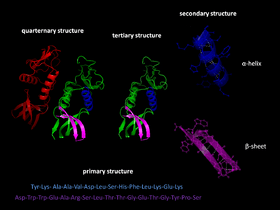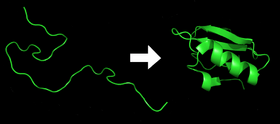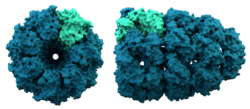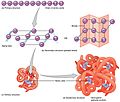Protein folding facts for kids

Protein folding is the process by which a protein gets its functional shape or 'conformation'. It is mainly a self-organising process. Starting from a random coil, polypeptides fold into their characteristic working shape. The structure is held together by hydrogen bonds.
The stages are:
- Each protein exists as an unfolded polypeptide or random coil when translated from a sequence of mRNA to a linear chain of amino acids. This polypeptide lacks any developed three-dimensional structure (left hand side of the top figure).
- Amino acids interact with each other to produce a well-defined three-dimensional structure, the folded protein (right hand side of the figure). This is known as the native state. The resulting three-dimensional structure is determined by the amino acid sequence (Anfinsen's dogma).
Without its correct three-dimensional structure a protein does not work. However, some parts of proteins may not fold: this is normal.
If proteins do not fold into their native shape, they are inactive and are usually toxic. Several diseases are believed to result from misfolded proteins. Many allergies are caused by the folding of the proteins, for the immune system does not produce antibodies for all possible protein structures.
Chaperones
Chaperonins are large proteins which help the folding of some proteins after synthesis. Chaperones in general were first discovered helping histones and DNA join up to form nucleosomes. Nucleosomes are the builing blocks for chromosomes. It is now clear that this is the way many cell organelles are built up.
Images for kids
-
The alpha helix spiral formation
-
Steps of X-ray crystallography
See also
 In Spanish: Plegamiento de proteínas para niños
In Spanish: Plegamiento de proteínas para niños








